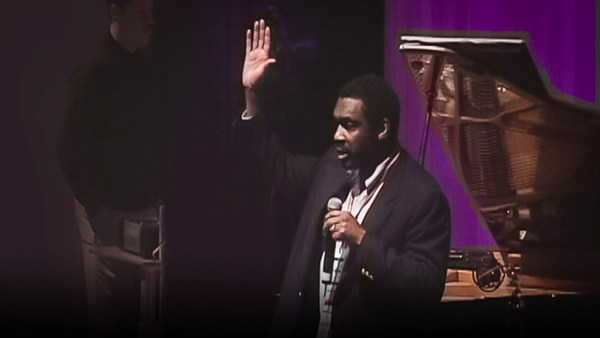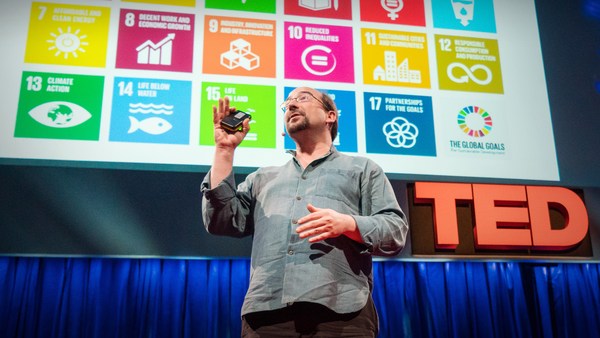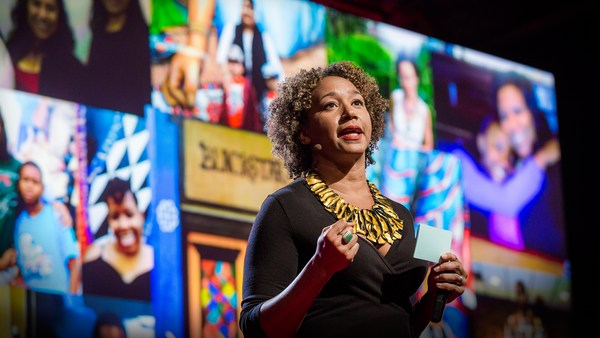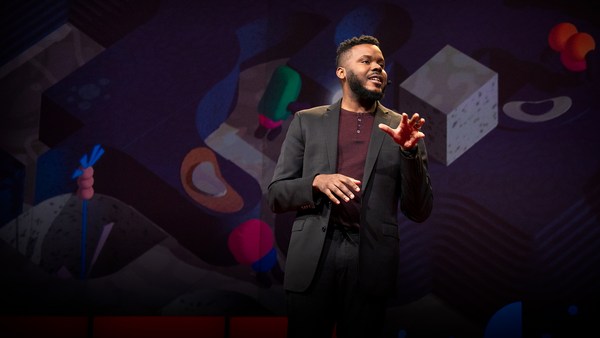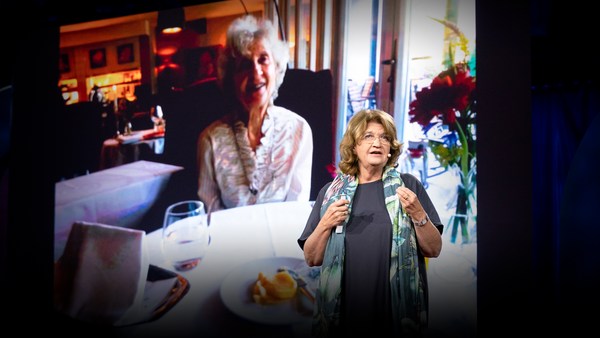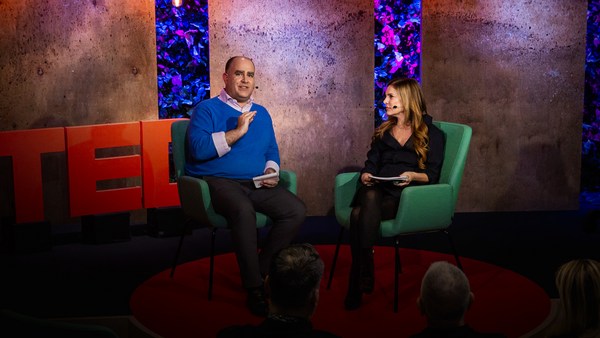I want to tell you three stories about the power of relationships to solve the deep and complex social problems of this century.
You know, sometimes it seems like all these problems of poverty, inequality, ill health, unemployment, violence, addiction -- they're right there in one person's life. So I want to tell you about someone like this that I know. I'm going to call her Ella. Ella lives in a British city on a run down estate. The shops are closed, the pub's gone, the playground's pretty desolate and never used, and inside Ella's house, the tension is palpable and the noise levels are deafening. The TV's on at full volume. One of her sons is fighting with one of her daughters. Another son, Ryan, is keeping up this constant stream of abuse from the kitchen, and the dogs are locked behind the bedroom door and straining. Ella is stuck. She has lived with crisis for 40 years. She knows nothing else, and she knows no way out. She's had a whole series of abusive partners, and, tragically, one of her children has been taken into care by social services. The three children that still live with her suffer from a whole range of problems, and none of them are in education. And Ella says to me that she is repeating the cycle of her own mother's life before her.
But when I met Ella, there were 73 different services on offer for her and her family in the city where she lives, 73 different services run out of 24 departments in one city, and Ella and her partners and her children were known to most of them. They think nothing of calling social services to try and mediate one of the many arguments that broke out. And the family home was visited on a regular basis by social workers, youth workers, a health officer, a housing officer, a home tutor and the local policemen. And the governments say that there are 100,000 families in Britain today like Ella's, struggling to break the cycle of economic, social and environmental deprivation. And they also say that managing this problem costs a quarter of a million pounds per family per year and yet nothing changes. None of these well-meaning visitors are making a difference.
This is a chart we made in the same city with another family like Ella's. This shows 30 years of intervention in that family's life. And just as with Ella, not one of these interventions is part of an overall plan. There's no end goal in sight. None of the interventions are dealing with the underlying issues. These are just containment measures, ways of managing a problem. One of the policemen says to me, "Look, I just deliver the message and then I leave."
So, I've spent time living with families like Ella's in different parts of the world, because I want to know: what can we learn from places where our social institutions just aren't working? I want to know what it feels like to live in Ella's family. I want to know what's going on and what we can do differently.
Well, the first thing I learned is that cost is a really slippery concept. Because when the government says that a family like Ella's costs a quarter of a million pounds a year to manage, what it really means is that this system costs a quarter of a million pounds a year. Because not one penny of this money actually touches Ella's family in a way that makes a difference. Instead, the system is just like this costly gyroscope that spins around the families, keeping them stuck at its heart, exactly where they are.
And I also spent time with the frontline workers, and I learned that it is an impossible situation. So Tom, who is the social worker for Ella's 14-year-old son Ryan, has to spend 86 percent of his time servicing the system: meetings with colleagues, filling out forms, more meetings with colleagues to discuss the forms, and maybe most shockingly, the 14 percent of the time he has to be with Ryan is spent getting data and information for the system. So he says to Ryan, "How often have you been smoking? Have you been drinking? When did you go to school?" And this kind of interaction rules out the possibility of a normal conversation. It rules out the possibility of what's needed to build a relationship between Tom and Ryan.
When we made this chart, the frontline workers, the professionals -- they stared at it absolutely amazed. It snaked around the walls of their offices. So many hours, so well meant, but ultimately so futile. And there was this moment of absolute breakdown, and then of clarity: we had to work in a different way.
So in a really brave step, the leaders of the city where Ella lives agreed that we could start by reversing Ryan's ratio. So everyone who came into contact with Ella or a family like Ella's would spend 80 percent of their time working with the families and only 20 percent servicing the system. And even more radically, the families would lead and they would decide who was in a best position to help them. So Ella and another mother were asked to be part of an interview panel, to choose from amongst the existing professionals who would work with them. And many, many people wanted to join us, because you don't go into this kind of work to manage a system, you go in because you can and you want to make a difference.
So Ella and the mother asked everybody who came through the door, "What will you do when my son starts kicking me?" And so the first person who comes in says, "Well, I'll look around for the nearest exit and I will back out very slowly, and if the noise is still going on, I'll call my supervisor." And the mothers go, "You're the system. Get out of here!" And then the next person who comes is a policeman, and he says, "Well, I'll tackle your son to the ground and then I'm not sure what I'll do." And the mothers say, "Thank you." So, they chose professionals who confessed they didn't necessarily have the answers, who said -- well, they weren't going to talk in jargon. They showed their human qualities and convinced the mothers that they would stick with them through thick and thin, even though they wouldn't be soft with them.
So these new teams and the families were then given a sliver of the former budget, but they could spend the money in any way they chose. And so one of the families went out for supper. They went to McDonald's and they sat down and they talked and they listened for the first time in a long time. Another family asked the team if they would help them do up their home. And one mother took the money and she used it as a float to start a social enterprise.
And in a really short space of time, something new started to grow: a relationship between the team and the workers. And then some remarkable changes took place. Maybe it's not surprising that the journey for Ella has had some big steps backwards as well as forwards. But today, she's completed an IT training course, she has her first paid job, her children are back in school, and the neighbors, who previously just hoped this family would be moved anywhere except next door to them, are fine. They've made some new friendships. And all the same people have been involved in this transformation -- same families, same workers. But the relationship between them has been supported to change.
So I'm telling you about Ella because I think that relationships are the critical resource we have in solving some of these intractable problems. But today, our relationships are all but written off by our politics, our social policies, our welfare institutions. And I've learned that this really has to change.
So what do I mean by relationships? I'm talking about the simple human bonds between us, a kind of authentic sense of connection, of belonging, the bonds that make us happy, that support us to change, to be brave like Ella and try something new. And, you know, it's no accident that those who run and work in the institutions that are supposed to support Ella and her family don't talk about relationships, because relationships are expressly designed out of a welfare model that was drawn up in Britain and exported around the world. The contemporaries of William Beveridge, who was the architect of the first welfare state and the author of the Beveridge Report, had little faith in what they called the average sensual or emotional man. Instead, they trusted this idea of the impersonal system and the bureaucrat who would be detached and work in this system. And the impact of Beveridge on the way the modern state sees social issues just can't be underestimated. The Beveridge Report sold over 100,000 copies in the first weeks of publication alone. People queued in the rain on a November night to get hold of a copy, and it was read across the country, across the colonies, across Europe, across the United States of America, and it had this huge impact on the way that welfare states were designed around the globe. The cultures, the bureaucracies, the institutions -- they are global, and they've come to seem like common sense. They've become so ingrained in us, that actually we don't even see them anymore. And I think it's really important to say that in the 20th century, they were remarkably successful, these institutions. They led to longer lifespans, the eradication of mass disease, mass housing, almost universal education. But at the same time, Beveridge sowed the seeds of today's challenges.
So let me tell you a second story. What do you think today is a bigger killer than a lifetime of smoking? It's loneliness. According to government statistics, one person over 60 -- one in three -- doesn't speak to or see another person in a week. One person in 10, that's 850,000 people, doesn't speak to anyone else in a month. And we're not the only people with this problem; this problem touches the whole of the Western world. And it's even more acute in countries like China, where a process of rapid urbanization, mass migration, has left older people alone in the villages. And so the services that Beveridge designed and exported -- they can't address this kind of problem. Loneliness is like a collective relational challenge, and it can't be addressed by a traditional bureaucratic response.
So some years ago, wanting to understand this problem, I started to work with a group of about 60 older people in South London, where I live. I went shopping, I played bingo, but mainly I was just observing and listening. I wanted to know what we could do differently. And if you ask them, people tell you they want two things. They want somebody to go up a ladder and change a light bulb, or to be there when they come out of hospital. They want on-demand, practical support. And they want to have fun. They want to go out, do interesting things with like-minded people, and make friends like we've all made friends at every stage of our lives. So we rented a phone line, hired a couple of handymen, and started a service we called "Circle." And Circle offers its local membership a toll-free 0 800 number that they can call on demand for any support. And people have called us for so many reasons. They've called because their pets are unwell, their DVD is broken, they've forgotten how to use their mobile phone, or maybe they are coming out of hospital and they want someone to be there. And Circle also offers a rich social calendar -- knitting, darts, museum tours, hot air ballooning -- you name it. But here's the interesting thing, the really deep change: over time, the friendships that have formed have begun to replace the practical offer.
So let me tell you about Belinda. Belinda's a Circle member, and she was going into hospital for a hip operation, so she called her local Circle to say they wouldn't see her for a bit. And Damon, who runs the local Circle, calls her back and says, "How can I help?" And Belinda says, "Oh no, I'm fine -- Jocelyn is doing the shopping, Tony's doing the gardening, Melissa and Joe are going to come in and cook and chat." So five Circle members had organized themselves to take care of Belinda. And Belinda's 80, although she says that she feels 25 inside, but she also says that she felt stuck and pretty down when she joined Circle. But the simple act of encouraging her to come along to that first event led to a process where natural friendships formed, friendships that today are replacing the need for expensive services. It's relationships that are making the difference.
So I think that three factors have converged that enable us to put relationships at the heart and center of how we solve social problems today. Firstly, the nature of the problems -- they've changed, and they require different solutions. Secondly, the cost, human as much as financial, of doing business as usual. And thirdly, technology.
I've talked about the first two factors. It's technology that enables these approaches to scale and potentially now support thousands of people. So the technology we've used is really simple, it's made up of available things like databases, mobile phones. Circle has got this very simple system that underpins it, enables a small local team to support a membership of up to a thousand. And you can contrast this with a neighborhood organization of the 1970s, when this kind of scale just wasn't possible, neither was the quality or the longevity that the spine of technology can provide.
So it's relationships underpinned by technology that can turn the Beveridge models on their heads. The Beveridge models are all about institutions with finite resources, anonymously managing access. In my work at the front line, I've seen again and again how up to 80 percent of resource is spent keeping people out. So professionals have to administer these increasingly complex forms of administration that are basically about stopping people accessing the service or managing the queue. And Circle, like the relational services that we and others have designed, inverts this logic. What it says is, the more people, the more relationships, the stronger the solution. So I want to tell you my third and final story, which is about unemployment. In Britain, as in most places in the world, our welfare states were primarily designed to get people into work, to educate them for this, and to keep them healthy. But here, too, the systems are failing. And so the response has been to try and make these old systems even more efficient and transactional -- to speed up processing times, divide people into ever-smaller categories, try and target services at them more efficiently -- in other words, the very opposite of relational.
But guess how most people find work today? Through word of mouth. It turns out that in Britain today, most new jobs are not advertised. So it's friends that tell you about a job, it's friends that recommend you for a job, and it's a rich and diverse social network that helps you find work. Maybe some of you here this evening are thinking, "But I found my job through an advert," but if you think back, it was probably a friend that showed you the ad and then encouraged you to apply. But not surprisingly, people who perhaps most need this rich and diverse network are those who are most isolated from it.
So knowing this, and also knowing about the costs and failure of current systems, we designed something new with relationships at its heart. We designed a service that encourages people to meet up, people in and out of work, to work together in structured ways and try new opportunities. And, well, it's very hard to compare the results of these new systems with the old transactional models, but it looks like, with our first 1,000 members, we outperformed existing services by a factor of three, at a fraction of the cost. And here, too, we've used technology, but not to network people in the way that a social platform would do. We've used it to bring people face to face and connect them with each other, building real relationships and supporting people to find work.
At the end of his life, in 1948, Beveridge wrote a third report. And in it he said he had made a dreadful mistake. He had left people and their communities out. And this omission, he said, led to seeing people, and people starting to see themselves, within the categories of the bureaucracies and the institutions. And human relationships were already withering. But unfortunately, this third report was much less read than Beveridge's earlier work.
But today, we need to bring people and their communities back into the heart of the way we design new systems and new services, in an approach that I call "Relational Welfare." We need to leave behind these old, transactional, unsuitable, outdated models, and we need to adopt instead the shared collective relational responses that can support a family like Ella's, that can address an issue like loneliness, that can support people into work and up the skills curve in a modern labor market, that can also address challenges of education, of health care systems, and so many more of those problems that are pressing on our societies. It is all about relationships. Relationships are the critical resource we have.
Thank you.
(Applause)
